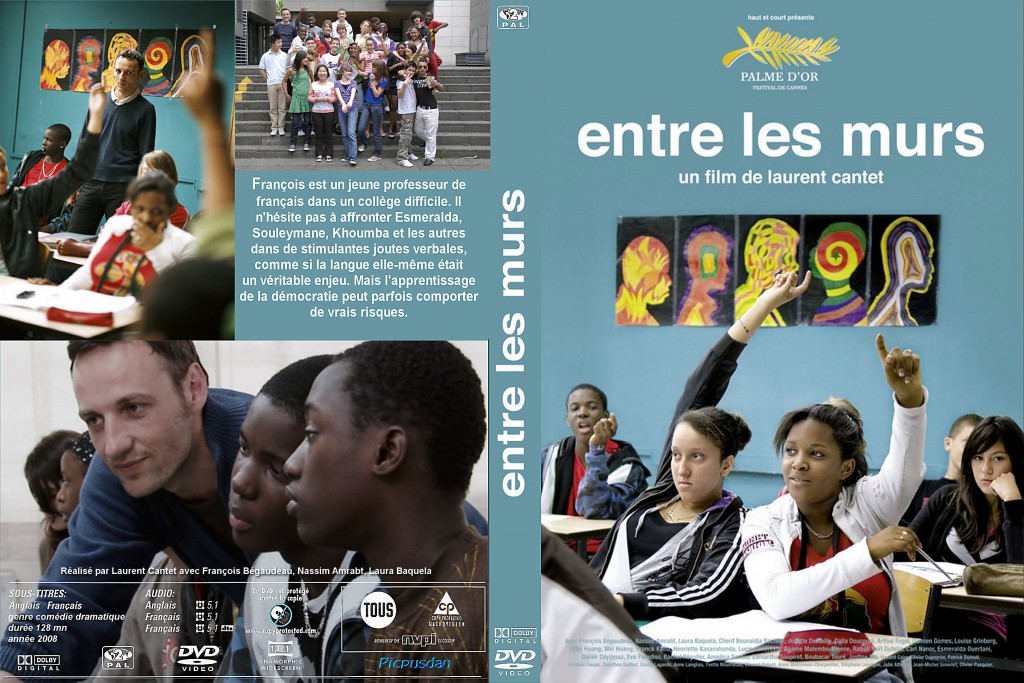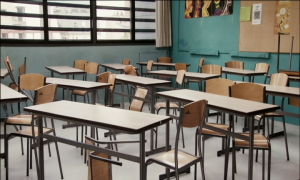Martin O’Shaughnessy
Nottingham Trent University
Cantet’s works often begin by showing a character returning to a context that they think they know, only to have their certainties challenged. The characters are in some ways our proxies. As we follow them and witness their experiences, our own certainties are put to the test. When Entre les murs starts, its hero, François, is returning to a familiar school for the start of a new school year. He thinks he knows the institution and the students within it. But can he be sure and, for our part, do we understand the republican school as well as we think?
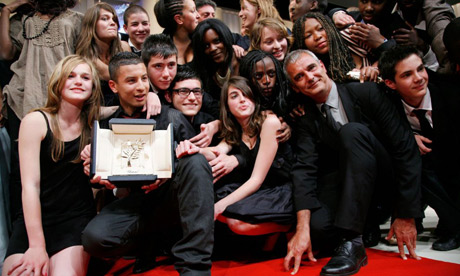 When the film won the Palme d’Or at Cannes in 2008, the first French film to do so for more than twenty years, the public response was overwhelmingly positive and gave little hint of the debate to come. Le Nouvel Observateur retrospectively summed up this initial reception: Libération was “enthused,” Xavier Darcos, the then Minister of Education, “motivated,” Jack Lang, the famous Socialist ex-Culture Minister, “fired up,” Le Figaro, “enchanted.”[1] Philosopher Alain Finkielkraut was predictably among the first dissenting voices. Responding to what he saw as an attack on those labelled “the fundamentalists of republican schooling” by François Bégaudeau, the film’s lead actor and the author of the eponymous 2006 book on which it is based, he sprang to the defense of traditional literary education and the capacity of great works to teach precision, nuance, and courtesy and to challenge the sort of socially consensual ideology to which the film, he felt, appealed.[2] Some teachers expressed their doubts about the pedagogic strategies deployed by the film’s hero.[3] Abandoning his earlier enthusiasm, Xavier Darcos now lamented the lack of authority shown in the film and criticized the film’s teacher for being too close to his pupils.[4] Taking a similar line, conservative leftist Jean-Pierre Chevènement, leader of the Mouvement républicain et citoyen, lamented what he saw as the film’s espousal of an over-relaxed, pupil-centred (“pédagogiste”) approach to learning.[5] With all these high-profile defenders of a traditional, disciplined, republican approach to education now lining up to criticize the film, one might have expected Philippe Meirieu, the leading voice of the pupil-centered pédagogues to spring to Cantet’s defence, but not a bit of it. He lamented the way in which the film’s teacher got bogged down in the affective and subjective and failed to develop a proper educational project or reflect on the mediations that were so vital to bridge the gap between the pupils’ experience and the school curriculum.[6] Cantet and his lead actor and co-writer, Bégaudeau, had clearly opened a can of worms. In a way typical of Cantet, a film that might initially seem to have a narrow focus –a year in the life of one class– opened up broader debates, especially, but not only, about the republican school and the mythology surrounding it.
When the film won the Palme d’Or at Cannes in 2008, the first French film to do so for more than twenty years, the public response was overwhelmingly positive and gave little hint of the debate to come. Le Nouvel Observateur retrospectively summed up this initial reception: Libération was “enthused,” Xavier Darcos, the then Minister of Education, “motivated,” Jack Lang, the famous Socialist ex-Culture Minister, “fired up,” Le Figaro, “enchanted.”[1] Philosopher Alain Finkielkraut was predictably among the first dissenting voices. Responding to what he saw as an attack on those labelled “the fundamentalists of republican schooling” by François Bégaudeau, the film’s lead actor and the author of the eponymous 2006 book on which it is based, he sprang to the defense of traditional literary education and the capacity of great works to teach precision, nuance, and courtesy and to challenge the sort of socially consensual ideology to which the film, he felt, appealed.[2] Some teachers expressed their doubts about the pedagogic strategies deployed by the film’s hero.[3] Abandoning his earlier enthusiasm, Xavier Darcos now lamented the lack of authority shown in the film and criticized the film’s teacher for being too close to his pupils.[4] Taking a similar line, conservative leftist Jean-Pierre Chevènement, leader of the Mouvement républicain et citoyen, lamented what he saw as the film’s espousal of an over-relaxed, pupil-centred (“pédagogiste”) approach to learning.[5] With all these high-profile defenders of a traditional, disciplined, republican approach to education now lining up to criticize the film, one might have expected Philippe Meirieu, the leading voice of the pupil-centered pédagogues to spring to Cantet’s defence, but not a bit of it. He lamented the way in which the film’s teacher got bogged down in the affective and subjective and failed to develop a proper educational project or reflect on the mediations that were so vital to bridge the gap between the pupils’ experience and the school curriculum.[6] Cantet and his lead actor and co-writer, Bégaudeau, had clearly opened a can of worms. In a way typical of Cantet, a film that might initially seem to have a narrow focus –a year in the life of one class– opened up broader debates, especially, but not only, about the republican school and the mythology surrounding it.
 In order to open up the complexity of Cantet’s film, it is useful to consider three different ways in which we might understand republican mythology. The first relates to the myth as a governing ideal, something towards which the school system works, or is meant to work, despite its blindspots and the compromises it necessarily has to make.[7] The second sense is closer to the common sense understanding of myth as a lie or deception. Here we might think of those thinkers who saw in republican mythology an alibi for class, gendered, and racialized oppressions. The work of Pierre Bourdieu is paradigmatic, particularly the classic analysis, La Reproduction (1970) he co-wrote with Jean-Claude Passeron.[8] The pair essentially claimed that, because it seemed to be egalitarian and meritocratic (the myth), the school was perfectly placed to carry out its work of symbolic violence. It imposed the recognition of the legitimacy of the dominant culture, rewarded the middle classes for their existing social capital and persuaded the working classes to take responsibility for their own exclusion.The third sense relates to the myth as nostalgia and rose to particular prominence in the 1990s in the face of what was seen as the threat from American models of multiculturalism or identity-based citizenship.[9] This nostalgic turn looked back to Jules Ferry and the Third Republic as a golden educational age. It found expression in the enthusiastic response accorded to Nicolas Philibert’s Être et avoir (2002), a film which, despite its contemporary setting, transported people to an earlier, more reassuring time. One of its best-known proponents is Alain Finkielkraut, who took so sharply against Entre les murs in the name of a purer, more traditional form of republican education. In what follows, I will essentially argue that, rather than committing to any one of these understandings of republican educational mythology, Cantet’s film holds them in tension, forcing us to work out where we stand.
In order to open up the complexity of Cantet’s film, it is useful to consider three different ways in which we might understand republican mythology. The first relates to the myth as a governing ideal, something towards which the school system works, or is meant to work, despite its blindspots and the compromises it necessarily has to make.[7] The second sense is closer to the common sense understanding of myth as a lie or deception. Here we might think of those thinkers who saw in republican mythology an alibi for class, gendered, and racialized oppressions. The work of Pierre Bourdieu is paradigmatic, particularly the classic analysis, La Reproduction (1970) he co-wrote with Jean-Claude Passeron.[8] The pair essentially claimed that, because it seemed to be egalitarian and meritocratic (the myth), the school was perfectly placed to carry out its work of symbolic violence. It imposed the recognition of the legitimacy of the dominant culture, rewarded the middle classes for their existing social capital and persuaded the working classes to take responsibility for their own exclusion.The third sense relates to the myth as nostalgia and rose to particular prominence in the 1990s in the face of what was seen as the threat from American models of multiculturalism or identity-based citizenship.[9] This nostalgic turn looked back to Jules Ferry and the Third Republic as a golden educational age. It found expression in the enthusiastic response accorded to Nicolas Philibert’s Être et avoir (2002), a film which, despite its contemporary setting, transported people to an earlier, more reassuring time. One of its best-known proponents is Alain Finkielkraut, who took so sharply against Entre les murs in the name of a purer, more traditional form of republican education. In what follows, I will essentially argue that, rather than committing to any one of these understandings of republican educational mythology, Cantet’s film holds them in tension, forcing us to work out where we stand.
Entre les murs as a Cantet film
Cantet’s films typically revolve around the tension between the individual, the group and the broader society and often involve moments of intense shame or embarrassment when individuals feel themselves judged by others who see the world differently.True to this pattern, Entre les murs begins with its hero as an apparently isolated and independent consciousness before relocating him in the sometimes-difficult setting of the school.The film does not simply work through its exploration of the tensions between equality and hierarchy, collectivity and separation at the level of abstraction. It does so through the embodied encounter between individuals and groups in the spatial context of the school.
Each Cantetian space has its own power dynamics that, initially unseen, are brought into view as the film progresses. Spaces are never entirely closed and outside forces press in.[10] The spatial economy of Entre les murs follows this pattern.The staff room is an egalitarian space of free-flowing exchange. In contrast, the classroom is an organized space of highly structured interaction: power inequalities are hard-wired into it.The schoolyard is again very different. Associated with playful activity, disagreement, or even violence, it is where the students are most free. Movement between spaces helps drive these contrasts and the power differentials associated with them into fuller view: when François, the hero, goes into the schoolyard to confront his students, he finds his authority and control of the situation challenged in a way that could not happen in the classroom.
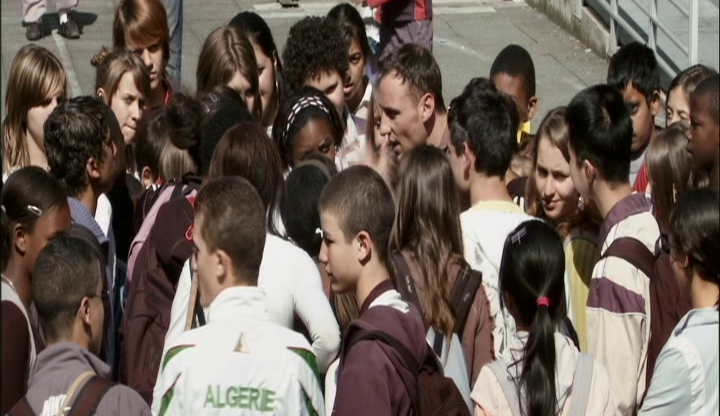 Moreover, although the film’s title (Entre les murs) seems to suggest that the school is self-contained, outside forces break in to remind us that its doors are permeable: the mother of Wei, a Chinese pupil, is picked up and threatened with deportation as a sans papiers; more generally, pupils and teachers bring identities, tastes and affiliations into the school with them. These spatial dynamics take us, in a very concrete way, to the heart of debates around the republican school and just what can and should be left outside its walls.
Moreover, although the film’s title (Entre les murs) seems to suggest that the school is self-contained, outside forces break in to remind us that its doors are permeable: the mother of Wei, a Chinese pupil, is picked up and threatened with deportation as a sans papiers; more generally, pupils and teachers bring identities, tastes and affiliations into the school with them. These spatial dynamics take us, in a very concrete way, to the heart of debates around the republican school and just what can and should be left outside its walls.
This debate is condensed in the understated but significant interaction between François, the hero, a teacher of French, and Fred, a history and geography teacher. Cantet’s characters, especially his leads, often have utopian attitudes that will be challenged by the encounter with others. No exception to this, François seeks to democratize the classroom, allowing free debate and trying to meet his pupils on their own ground, much as the student-centered pédagogues do. Fred is a traditionalist. He is teaching the ancien régime and wants François to collaborate with him by teaching Enlightenment literature,Voltaire for example. François feels Voltaire will be too hard and opts to work on The Diary of Anne Frank, something to which his teenaged students are more likely to relate. Fred is for the uniform application of the rules to all students. François is in favor of local adaptations. Both are present at the conseil de discipline that leads to the expulsion of Souleymane after the boy, having learned that François has described him as limité, has lost control. François worries that he may be sent “home” to Mali.
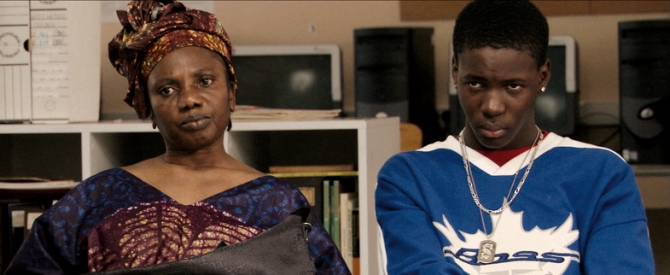 He is aware of what happens outside school and its impact within it. Fred feels that it is no concern of theirs and that, in any case, Souleymane has rejected the school, a judgement that clearly echoes Bourdieu and Passeron’s argument that the republican school masks its exclusion of the working classes by making it seem as if they had excluded themselves.The disciplinary hearing itself, the most formal scene in the film, bears the hallmarks of republican democracy.There are parent, teacher and pupil representatives, and, after deliberation has taken place, votes are cast in a transparent ballot box.Yet, as François himself points out, all the hearings they have held that year have ended in expulsion and, as one of the parents observes, François himself is both judge and party in the case. Despite its ostentationally signaled transparency, republican justice may not be as fair as it claims and all voices may not be equal. Having triggered Souleymane’s outburst, François does not come off well.The teenager’s departure underscores his failure to integrate all his class, despite his utopian aspirations.Yet Fred’s rigid republican stance and refusal to consider how the institution might itself be at fault, hardly seems adequate either.The film, as is typical of Cantet, confronts us with a complex situation and asks us to decide where we stand.
He is aware of what happens outside school and its impact within it. Fred feels that it is no concern of theirs and that, in any case, Souleymane has rejected the school, a judgement that clearly echoes Bourdieu and Passeron’s argument that the republican school masks its exclusion of the working classes by making it seem as if they had excluded themselves.The disciplinary hearing itself, the most formal scene in the film, bears the hallmarks of republican democracy.There are parent, teacher and pupil representatives, and, after deliberation has taken place, votes are cast in a transparent ballot box.Yet, as François himself points out, all the hearings they have held that year have ended in expulsion and, as one of the parents observes, François himself is both judge and party in the case. Despite its ostentationally signaled transparency, republican justice may not be as fair as it claims and all voices may not be equal. Having triggered Souleymane’s outburst, François does not come off well.The teenager’s departure underscores his failure to integrate all his class, despite his utopian aspirations.Yet Fred’s rigid republican stance and refusal to consider how the institution might itself be at fault, hardly seems adequate either.The film, as is typical of Cantet, confronts us with a complex situation and asks us to decide where we stand.
 Part of the film’s complexity resides in the refusal to give us any clear resolution.The teachers come together to support Wei’s mother in her fight to stay in France, not least because the boy is so obviously thriving in the school, a perfect example of successful integration.Yet some of the same teachers are involved in one way or another with Souleymane’s expulsion. Does republican schooling integrate or exclude or both? Can it only in fact integrate eager students like Wei? The film’s penultimate scene seems set to offer a hopeful answer. A soccer game in the yard brings together teachers and pupils, as both players and spectators.
Part of the film’s complexity resides in the refusal to give us any clear resolution.The teachers come together to support Wei’s mother in her fight to stay in France, not least because the boy is so obviously thriving in the school, a perfect example of successful integration.Yet some of the same teachers are involved in one way or another with Souleymane’s expulsion. Does republican schooling integrate or exclude or both? Can it only in fact integrate eager students like Wei? The film’s penultimate scene seems set to offer a hopeful answer. A soccer game in the yard brings together teachers and pupils, as both players and spectators.
 It seems to serve as a riposte to earlier moments in the film when soccer divided the students, some supporting the African or Arab teams from the countries they come from, and others France. But then, in the film’s final shot, and even as the now off-screen sound of the joyful soccer game continues, we see François’s empty classroom, with its chairs pushed back, reminding us of the absent students and all that took place in the room, especially the confrontation with Souleymane. Instead of a simple ending, we are left with a layered, ambiguous one. The film will not make up our minds for us.
It seems to serve as a riposte to earlier moments in the film when soccer divided the students, some supporting the African or Arab teams from the countries they come from, and others France. But then, in the film’s final shot, and even as the now off-screen sound of the joyful soccer game continues, we see François’s empty classroom, with its chairs pushed back, reminding us of the absent students and all that took place in the room, especially the confrontation with Souleymane. Instead of a simple ending, we are left with a layered, ambiguous one. The film will not make up our minds for us.
Moving in closer: four moments
To get a better sense of the film’s complexity, it is worth examining a few key scenes. I will look at four.The first, rather amusing one occurs early on. Wanting to explain the meaning of “succulent,” François writes a sentence on the blackboard: “Bill savors a succulent cheeseburger,” the cheeseburger bearing witness to his desire to build bridges to the students’ experience. Khoumba and Esmeralda see things differently. Why, they ask, is it always names like Bill and not other names that better reflect the diversity in the class? Bill is a perfectly acceptable name, François notes, the name of a recent American president. The girls persist. François agrees to replace Bill with Aïssata, a name they have suggested. On the surface, this seems trivial, an example of tokenism rather than something more weighty. But something more important is at stake. When François uses Bill, it is just as the subject in the sentence, perhaps called forth by the Americanness of the cheeseburger.What the girls challenge is the neutrality of the choice. If the name is playing a purely abstract, grammatical role, why cannot a woman’s name, one associated with Islam, or West Africa, or perhaps all three, do? Are some names more capable of neutrality than others? This goes to the heart of the exclusions lurking in republican universalism. But, at the same time, the classroom is a place where young women can give voice to their critical reason and challenge their implicit marginalization.
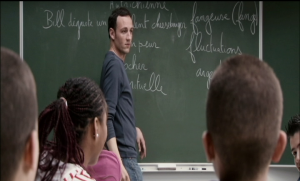 The second scene, again an amusing one, is another language lesson.[11]
The second scene, again an amusing one, is another language lesson.[11]
François: Est-ce que quelqu’un peut me donner un exemple de l’imparfait du subjonctif
Khoumba: Je fusse, nous fussions, vous fussiez, ils fussent …
François: C’est pas si bête. Tu ne sais pas l’utiliser. Tu as retenu une vague terminaison …
Esmeralda: Vous croyez vraiment que, je vais aller voir ma mère, que je lui dirais “il fallait que je sois fusse…”
François: Avant même de maîtriser un savoir … vous êtes en train de me dire qu’il ne sert à rien …
François: Hier, avec des amis, on utilisait l’imparfait du subjonctif …
Khoumba: C’est les bourgeois …
François: L’important est de bien mesurer le fait qu’il y a plusieurs registres … Il faut savoir alterner entre le familier, le courant et le soutenu, l’oral et l’écrit …
Lucie: Comment on sait si c’est à l’écrit, si c’est à l’oral? …
François: … Il faut se servir un petit peu de l’intuition….
The scene lends itself well to a Bourdieusian critique of the republican school and its false inclusiveness. Although the teacher means to convey the finer points of the French language, one of the traditional roads to successful integration, he is patronizing and uses the pupils’ mistakes or partial answers as raw materials for his demonstration of a superior, more generally valid knowledge. He is also unwittingly confirming one of the main points made by Bourdieu and Passeron: that the school rewards the social and symbolic capital of the middle classes so that a system that seems open to all in fact favors the already privileged. Unlike his students who want to know the usefulness of a piece of knowledge –a position Bourdieu associates with the popular classes (in La Distinction)– he has a more distanced attitude to language, drawing on an acquaintance with linguistic convention (“intuition”) from his upbringing that his pupils lack. On the other hand, we might note how the scene underscores both the capacity of the students to challenge the teacher’s positions and the (republican) invitation made by the latter to the pupils to take a critical distance from their own immediate experience of language use. The way in which the viewpoint of one individual or group is used to highlight the blindspots of another is typically Cantetian.
 The third scene I will discuss is a short one, a long single take, showing Carl, a new boy in the class, delivering the self-portrait that everyone has been asked to write in response to Anne Frank’s account of herself. Carl delivers a list of likes (playing soccer, pretty girls, TV series, holidays in the Caribbean, where his family is from, Zouk and Dancehall music, his housing estate …) and dislikes (Goths and skateboarders, the Star Academy TV series, racists, the war in Iraq, people who cry, his previous school …).The list is a disparate combination of local and distant connections, subcultural affinities, political opinions, consumer tastes and personal experiences, and points implicitly to the pitfalls of François’s pupil-centered pedagogy. Discussion of Anne Frank’s famous journal could have invited all the students to display a (republican) distance from their own experience and stress the potential savagery of models of citizenship that aim at cultural uniformity. Instead, it seems to throw the pupils back on their individual identities and tastes, and to isolate them.The way Carl is framed by the empty space of the blackboard behind him, underscores his separation from the group.
The third scene I will discuss is a short one, a long single take, showing Carl, a new boy in the class, delivering the self-portrait that everyone has been asked to write in response to Anne Frank’s account of herself. Carl delivers a list of likes (playing soccer, pretty girls, TV series, holidays in the Caribbean, where his family is from, Zouk and Dancehall music, his housing estate …) and dislikes (Goths and skateboarders, the Star Academy TV series, racists, the war in Iraq, people who cry, his previous school …).The list is a disparate combination of local and distant connections, subcultural affinities, political opinions, consumer tastes and personal experiences, and points implicitly to the pitfalls of François’s pupil-centered pedagogy. Discussion of Anne Frank’s famous journal could have invited all the students to display a (republican) distance from their own experience and stress the potential savagery of models of citizenship that aim at cultural uniformity. Instead, it seems to throw the pupils back on their individual identities and tastes, and to isolate them.The way Carl is framed by the empty space of the blackboard behind him, underscores his separation from the group.
 The final scene I will consider is the one, near the end of the film, in which François asks each of the students what they have learned during the school year. Esmeralda says that she has learned nothing in school but has been reading an amazing book called La République about a guy who asks people if they are sure they know what they think they know and do what they think they are doing. François is visibly taken aback but his questioning reveals that the girl has indeed read and made sense of Plato.The interchange drips with irony and is rich in implications. Throughout the film François has been something of a Socratic teacher, asking his pupils if they are sure they really think what they think, forcing them to take the critical distance from their own positions that a properly republican education requires. But the problem with this mode of teaching, as Jacques Rancière so convincingly demonstrates in Le Maître ignorant (1987)[12], is that it casts the teacher as the one who knows and puts the pupil as the eternal minor who needs to be asked the right questions.The promised republican equality is endlessly deferred.The film turns the tables beautifully: François thought he knew Esmeralda and what she was capable of. He was wrong. He is the one whose certainties are now questioned as Esmeralda asserts her equal capacity to reflect, and shows us how the encounter with the literary text can open up a critical distance between us and our social roots. But what exactly is happening here? Is it a reminder of the promise of republican education, the republic not as a nostalgic myth or a lie, but as an active principle? Or does it suggest that the school, as a hierarchical institution, is incapable of living up to its values and that equality can only truly be realized despite it and en dehors des murs? The film will not tell us. We will have to make up our own minds. [13]
The final scene I will consider is the one, near the end of the film, in which François asks each of the students what they have learned during the school year. Esmeralda says that she has learned nothing in school but has been reading an amazing book called La République about a guy who asks people if they are sure they know what they think they know and do what they think they are doing. François is visibly taken aback but his questioning reveals that the girl has indeed read and made sense of Plato.The interchange drips with irony and is rich in implications. Throughout the film François has been something of a Socratic teacher, asking his pupils if they are sure they really think what they think, forcing them to take the critical distance from their own positions that a properly republican education requires. But the problem with this mode of teaching, as Jacques Rancière so convincingly demonstrates in Le Maître ignorant (1987)[12], is that it casts the teacher as the one who knows and puts the pupil as the eternal minor who needs to be asked the right questions.The promised republican equality is endlessly deferred.The film turns the tables beautifully: François thought he knew Esmeralda and what she was capable of. He was wrong. He is the one whose certainties are now questioned as Esmeralda asserts her equal capacity to reflect, and shows us how the encounter with the literary text can open up a critical distance between us and our social roots. But what exactly is happening here? Is it a reminder of the promise of republican education, the republic not as a nostalgic myth or a lie, but as an active principle? Or does it suggest that the school, as a hierarchical institution, is incapable of living up to its values and that equality can only truly be realized despite it and en dehors des murs? The film will not tell us. We will have to make up our own minds. [13]
Laurent Cantet, Director, Entre les murs [The Class], 2008, Color, 128 min, France, Haut et Court, France 2 Cinéma, Canal+, CinéCinéma, et al.
NOTES
- Le Nouvel Observateur, 6/12/2008, my translations here and throughout.
- Le Monde 6/4/2008
- Telerama, 9/17/2008
- L’Express, 9/26/2008
- Le Figaro, 9/24/2008
- http://www.meirieu.com/ACTUALITE/entrelesmurs.htm
- Dominique Schnapper notes how, despite its state centralism and drive to an abstract model of citizenship, republican universalism necessarily had to negotiate with particular customs and traditions and engage with social inequality, as evoked in the famous “question sociale.” (“L’universel républicain revisité,” VEI Enjeux, 121, June 2000, pp. 10-22).
- Pierre Bourdieu and Jean-Claude Passeron, La Reproduction. Éléments pour une théorie du système d’enseignement. Paris: Editions de Minuit, 1970
- See Joan Wallach Scott, “French universalism in the nineties,” Differences, 15:2, pp. 32-53.
- On Cantet’s use of space, see James Williams, Space and Being in Contemporary French Cinema, Manchester: Manchester University Press, 2013, 147-86.
- François asks for an example of the imperfect subjunctive. Khoumba conjugates the imperfect subjunctive of the verb to be. François congratulates her for vaguely remembering a verb ending. Esmeralda comments that she would hardly use that verb form with her mother. François retorts that they should master a piece of knowledge before rejecting it and adds that, only the day before, he had been using the imperfect subjunctive with friends. They are bourgeois, comments Khoumba. You need to realize there are different registers, replies François. How do you know if it’s written or spoken language, asks Lucie. Intuition, replies François.
- Jacques Rancière, Le Maître ignorant: Cinq leçons sur l’émancipation intellectuelle, Paris: Fayard 1987.
- For a fuller sense of my reading of the film, see my Laurent Cantet, Manchester: Manchester University Press, 2015, pp.124-152.
